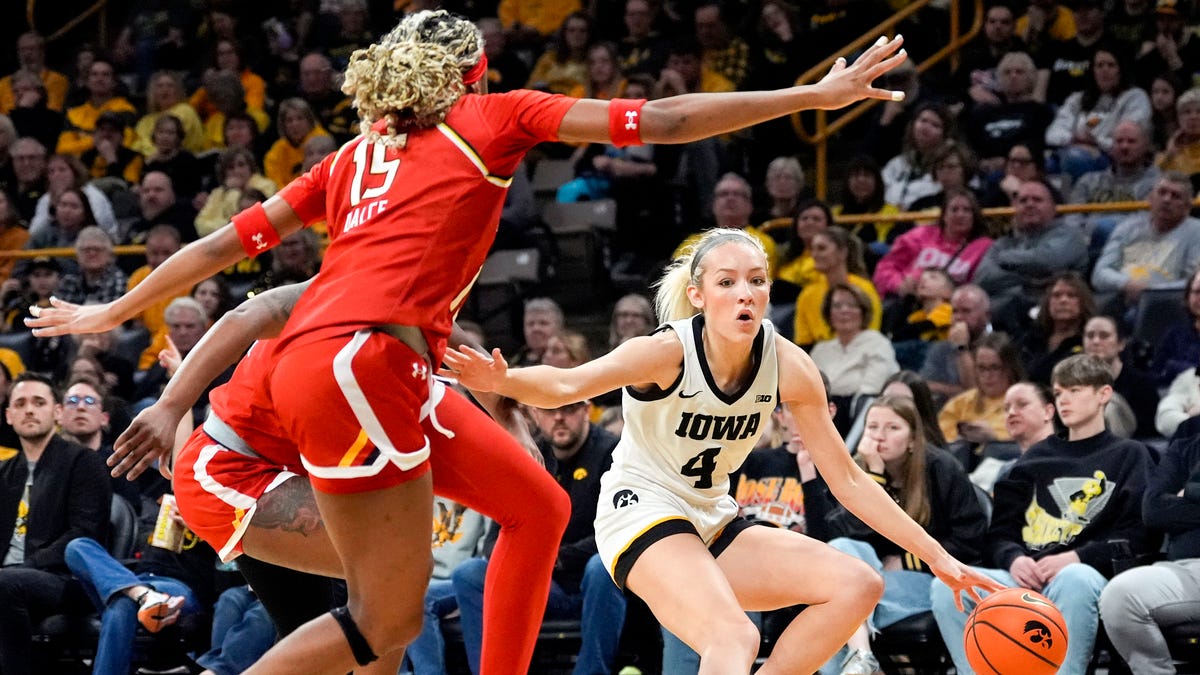Maryland
Grading Maryland football’s position groups after its loss to No. 3 Michigan

Maryland football twice had an opportunity to take a late lead against No. 3 Michigan.
But it was ultimately unable to overcome a disastrous five-minute span in the second quarter, and the undefeated Wolverines escaped College Park with a 31-24 victory.
Here’s how every Maryland position group performed against Michigan.
Quarterback
Michigan had not allowed an opponent this season to score more than 15 points before Saturday’s game. It also had an average margin of victory of six touchdowns.
Taulia Tagovailoa, although coming up just short, delivered a valiant performance in his final home game. And you can’t fail to mention Billy Edwards Jr.’s three rushing scores.
However, Tagovailoa’s late interception and early fumble each came in a crucial spot.
His 241-yard performance captured what Tagovailoa’s entire Maryland career has shown: a lot of highs, with some crushing lows.
Grade: B
Running back
Maryland’s rushing game found a rhythm in the second half at Nebraska, but came crashing back down to earth against the Wolverines’ top-10 defense.
56 yards on 20 carries is a more efficient performance than most in recent weeks, but no running back managed an explosive play — or a run of more than seven yards, at that.
Grade: C-
Wide receiver
Not seeing a receiver fumble was a positive sight for the Terps, and the unit had a successful afternoon overall.
Kaden Prather once again made the highlight reel, hauling in a contested 34-yard catch. His 81 yards led all Terps, but Tai Felton saw the most action, with five catches for 41 yards on 10 targets.
Jeshaun Jones also tacked on 70 yards in his last game at SECU Stadium.
Grade: B
Tight end
Corey Dyches’ production has been up-and-down this season, and on Saturday, he was a reliable, yet fairly inefficient source. He caught all five of his targets for 26 yards. He also didn’t see an overwhelming number of snaps in blocking situations, per usual.
Grade: C+
Offensive line
What’s been known all season was once again made clear against Michigan. Maryland’s offensive line isn’t horrendous, but it is far from being able to compete against the best.
Protection held up alright, but when it didn’t, the results were costly. The unit gave up four sacks for a loss of 49 yards.
Grade: C-
Defensive line
Michigan’s offensive line has won the Joe Moore Award — given to the best unit in the nation — in each of the past two years, and the Wolverines had success at the line of scrimmage.
Blake Corum ran to the tune of 94 yards and two touchdowns on 28 carries and Donovan Edwards tacked on 39 yards. Both players’ performances were still less efficient than their season averages, though.
And when the Terps needed stops in the fourth quarter to give the offense a chance, Michigan’s running backs found themselves constantly stood up.
Grade: B+
Linebacker
One of the biggest plays of the game came late in the first half. Deep in Maryland territory with a chance to go up 20, Michigan quarterback J.J. McCarthy threw the ball into the hands of Jaishawn Barham. Not only did the pick keep the deficit at two scores, but it was Barham’s first career interception.
That play gave Maryland’s defense a bolt of energy, as Michigan’s offense scored just once after that.
Barham and Ruben Hyppolite II were dominant all afternoon, clogging up the middle of the field and combining for 17 tackles — eight of those solo.
Grade: B+
Secondary
Lights-out is the only way to describe the secondary, albeit it should be noted that Michigan’s top target, Roman Wilson, exited the game early.
McCarthy struggled to find receivers thereafter, ending his day 12-of-23 passing for 141 yards.
Beau Brade and Ja’Quan Sheppard each finished with a pass breakup and tackle for loss, with no play more memorable than Sheppard’s thunderous second-half sack on McCarthy.
Grade: A
Special teams
We should’ve known it would be a wacky day after it took three tries for Jack Howes to send the opening kickoff deep.
Howes made his lone field goal attempt, a 35-yarder, and Brenden Segovia had a tough day with Colton Spangler still off punting duties.
Segovia’s first punt was blocked for a safety — an eventual nine-point swing — and his second went just 32 yards.
Grade: D
Coaching
Maryland put together a good game plan to pull off the unthinkable. It came out with an early score and had a chance to win in the end.
Unlike past weeks, no questionable play calls stood out, but a loss is still a loss.
Grade: B+

Maryland
Did Iowa women’s basketball remain in the Associated Press top 25 after Maryland loss?

Sydney Affolter, Lucy Olsen on Iowa women’s basketball loss to Maryland
Hear from Sydney Affolter, Lucy Olsen after Iowa women’s basketball falls to Maryland
Following Sunday’s loss to then-No. 7 Maryland, Iowa women’s basketball could’ve taken a tumble in the latest Associated Press top 25. However, the Hawkeyes are still ranked.
Iowa (12-3, 2-2 Big Ten Conference) remained at No. 23 after the 74-66 home loss to the Terrapins that snapped the Hawkeyes’ 21-game Big Ten home winning streak. It was a game in which Iowa fell behind by as much as 25 points before rallying to make things respectable in the second half.
Iowa will look to rebound Thursday night at Illinois. The Hawkeyes are 1-1 in conference road games, having stumbled at Michigan State in mid-December before pulling out an 80-68 win at Penn State on New Year’s Day. Tipoff at Illinois is set for 6 p.m. on BTN+.
Latest Associated Press top 25
- UCLA (15-0)
- South Carolina (14-1)
- Notre Dame (12-2)
- USC (14-1)
- Texas (15-1)
- LSU (17-0)
- UConn (13-2)
- Maryland (14-0)
- Ohio State (14-0)
- Oklahoma (13-2)
- TCU (15-1)
- Kansas State (15-1)
- Georgia Tech (16-0)
- Duke (12-3)
- Kentucky (13-1)
- Tennessee (13-1)
- West Virginia (12-2)
- Alabama (15-1)
- North Carolina (13-3)
- Michigan State (12-2)
- North Carolina State (11-3)
- Utah (12-2)
- Iowa (12-3)
- California (14-2)
- Michigan (10-4)
Dargan Southard is a sports trending reporter and covers Iowa athletics for the Des Moines Register and HawkCentral.com. Email him at msouthard@gannett.com or follow him on Twitter at @Dargan_Southard.
Maryland
Maryland, Baltimore City declare state of emergency as winter storm nears

Maryland
No. 8 Maryland women’s basketball picks up statement road victory over No. 23 Iowa, 74-66

No. 8 Maryland women’s basketball walked into a sold out Carver-Hawkeye Arena and made a statement against No. 23 Iowa. It led by 25 points less than a minute before halftime.
But the Terps had to survive a fighting comeback effort after a big first-half lead in order to take a 74-66 win over the Hawkeyes, whose 20-game home win streak dating back to last season ended Sunday.
“Really impressed with this group’s poise and composure,” head coach Brenda Frese said. “This group just found different ways to win. I loved our first half. We knew Iowa was going to come back in that second half.”
After Iowa scored first, Maryland went on a 13-0 run and didn’t let up from there, beginning the contest 5-of-7 from 3-point range.
But as great as a start Maryland put together, momentum flipped in the latter end of the first quarter. Iowa inserted a freshman-heavy lineup and went on a 7-0 run that cut Maryland’s lead to seven points after the first quarter. The Terps led by as much as 14 points in the frame, but kept missing shots despite an abundance of offensive rebounds. Five of Christina Dalce’s six rebounds in the first 10 minutes were on the offensive end.
Maryland was dominant to start the second quarter, putting together an 18-1 run to extend its lead to 24 points. The Terps outmatched Iowa on the boards, forced turnovers at will and moved the ball fluidly.
The Terps headed to the break up by 21 points after a small Iowa push, but the Terps made a statement in their biggest road test to this point.
Maryland was 9-of-17 from deep in the first half. It hadn’t converted more than 11 3-pointers in any of its previous 13 games.
Shyanne Sellers and Kaylene Smikle both scored 14 points in the first half, and Maryland’s defense did a masterful job containing Iowa. No Hawkeye scored more than four points except Lucy Olsen with 11.
Iowa came out of the half with some life. After Saylor Poffenbarger started the period with a triple, the Hawkeyes went on a 12-0 run and the crowd erupted.
“I think Iowa came out with punches [in the] second half,” Smikle said. “But we know how to play through that. We aren’t going to crumble from teams going on runs, because that’s just how basketball is.”
The Terps were held scoreless for more than four minutes before Smikle went 1-of-2 from the charity stripe. Maryland made its first field goal of the half before missing its next seven — a Bri McDaniel fadeaway jumper ended the shooting drought.
The Terps held Hannah Stuelke, who entered the game averaging 13.6 point per game, to one point through three quarters, and she was in foul trouble with four fouls.
After scoring 48 in the first half, the Terps only scored 11 points in the third period. Although they still led by 16 points, Iowa stole some of the momentum.
The Hawkeyes started the fourth on a 5-0 run to cut Maryland’s lead to 11, but a steal and finish by Smikle silenced the Iowa crowd.
The Hawkeyes brought the deficit to single-digits, as their comeback effort was in full force. It became a two-possession game halfway through the fourth quarter, and the Terps were in severe danger, succumbing to poor shot selection.
The Terps made a few clutch shots down the stretch and connected when necessary, but a late Iowa run cut the deficit to five points with 44 seconds remaining.
Once again, the Terps came through when they needed to, making free throws and playing strong defense to hold on to the win.
Three things to know
1. Big Ten road win. Maryland survived its toughest road test thus far Sunday, improving to 14-0 on the season. It could easily serve as the most difficult road environment the Terps will see all season, and they held strong.
“This is a tough place to play, and I think we played really hard and we pulled it out,” Sellers said.
2. Smikle shows off. Smikle scored a season-high 26 points Sunday. She went 4-of-5 from three, 8-of-17 from the field and 6-of-8 from the free-throw line.
3. Less turnovers, but less rebounds. For the first time this season, Maryland was out-rebounded, 44-41, after a big second half on the boards for Iowa. Maryland won the turnover margin, though, with 15 steals and 22 forced turnovers.
-

 Health1 week ago
Health1 week agoNew Year life lessons from country star: 'Never forget where you came from'
-
/cdn.vox-cdn.com/uploads/chorus_asset/file/24982514/Quest_3_dock.jpg)
/cdn.vox-cdn.com/uploads/chorus_asset/file/24982514/Quest_3_dock.jpg) Technology1 week ago
Technology1 week agoMeta’s ‘software update issue’ has been breaking Quest headsets for weeks
-

 Business6 days ago
Business6 days agoThese are the top 7 issues facing the struggling restaurant industry in 2025
-

 Culture5 days ago
Culture5 days agoThe 25 worst losses in college football history, including Baylor’s 2024 entry at Colorado
-

 Sports5 days ago
Sports5 days agoThe top out-of-contract players available as free transfers: Kimmich, De Bruyne, Van Dijk…
-

 Politics4 days ago
Politics4 days agoNew Orleans attacker had 'remote detonator' for explosives in French Quarter, Biden says
-

 Politics4 days ago
Politics4 days agoCarter's judicial picks reshaped the federal bench across the country
-

 Politics2 days ago
Politics2 days agoWho Are the Recipients of the Presidential Medal of Freedom?








/cdn.vox-cdn.com/uploads/chorus_asset/file/25820156/.jpg)










